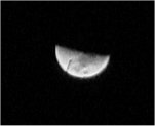Night in the Tropics
Jack Kramer
This January, my wife and I took an extended vacation in Costa Rica; at 10o north latitude, it's the farthest south I've ever been. Familiar objects are situated differently in the sky than they are back home. Then there are those objects that are completely inaccessible from up north here.
It took me awhile to get oriented. Orion was directly overhead. But the biggest surprise was how the ecliptic arches up toward the north. At first I couldn't find Saturn, then realized it was actually north of the zenith. And even other tourists who casually glanced at the sky remarked about the crescent moon with its cusps pointed straight up, like a Cheshire cat's grin. In fact, as the moon sank lower in the sky, the cusps pointed in a slightly northerly direction. I took the photo here from our hotel in the city of San Jose, holding the camera horizontally and looking toward the west. Notice how the moon is facing. Because of clouds covering the mountains ringing San Jose, the best views were overhead; I was lucky to get this picture through a break in those clouds.

The last half of the trip was spent at Manuel Antonio, on the Pacific coast. As usual, conditions don't always cooperate. First of all, the moon had by then advanced beyond first quarter phase, so the sky was not really dark. Secondly, while the days were totally sunny, clouds and haze appeared every night. This is typical of the tropics. Much of Costa Rica is covered with dense vegetation and rain forests that give off a haze which becomes especially obvious in the night sky. Beautiful sunsets are the norm, but that's just because the nighttime clouds are beginning to form. Manuel Antonio is an ecological preserve, so there was a minimum of ground illumination, and of course, no lights at all from the southwest over the ocean. Unfortunately, all my observing on this trip was through sucker holes. (Sound familiar?)
From back home, the bright navigation star Canopus never gets above our horizon. But at 10o north it rises to almost 30o up in the sky. Using 9x60 binoculars and starting at Canopus, I tried to star-hop to a few of the brighter deep sky objects. I succeeded in catching a fleeting look at the Large Magellanic Cloud, which extended beyond the field of my binoculars. I couldn't see it naked eye because of competition from moonlight and haze, and the appearance through the binoculars was also compromised by the haze.
The best view I had of any deep sky object was of the large, bright open cluster NGC 2516 in Carina - a pretty sight in binoculars. The cluster spans about a half degree with stars of magnitude 7 and fainter. One of the other objects I tried for was Crux - the Southern Cross - but it never rose out of the horizon muck.
I had great plans for observing on this trip, and had brought the current issue of S&T with its monthly Southern Hemisphere star chart. It was barely adequate. A better plan would have been to print out a detailed star chart from one of the planetarium computer programs, oriented for the exact latitude of observation. The experience of trying to identify unfamiliar constellations made me feel pretty much like a novice amateur astronomer again. The suggestion given to beginning star hoppers is to locate a known object, then move out from there. In this case, my starting point each night was Canopus.
While the brightest stars could often be seen, deep sky objects were generally masked by thin clouds and haze. (And this was the dry season down there!) Costa Rica is certainly a vacation paradise...but not an astronomer's paradise!





